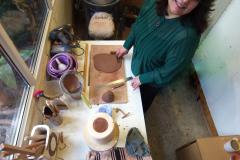The maker's hand imprints. The tool leaves a mark. The glaze runs and coats the surface. The fire alters physical properties. All processes leave hints of how the ceramic artefact came into being. In my practice-led research I look beyond traditional processes and explore the integration of 2D laser technology as a mark making tool and a heat source. I am driven by my interest in how ceramic surfaces reveal and reflect the processes they have been subjected to. Process and material – one is dependent on the other and inseparable after firing.
 I am fascinated with the laser beam as a heat source and how it "fires" the red clay surface, revealing its many true colours without the suffocation of glazes. A matte finish absorbs more light than it reflects and can be more subtle. I believe natural materials have more depth and gravitas if allowed to breathe and show off their natural finishes of colour and textural quality, provoking interest, rather than relying on pattern or surface decoration alone. My contemporary vessels are handmade and I use a terra sigillata surface, as did potters from antiquity. My vessels reference the modern urban architecture of my birthplace and home, Canada, while the material and geometric surface patterns bring into focus my Greek heritage.
I am fascinated with the laser beam as a heat source and how it "fires" the red clay surface, revealing its many true colours without the suffocation of glazes. A matte finish absorbs more light than it reflects and can be more subtle. I believe natural materials have more depth and gravitas if allowed to breathe and show off their natural finishes of colour and textural quality, provoking interest, rather than relying on pattern or surface decoration alone. My contemporary vessels are handmade and I use a terra sigillata surface, as did potters from antiquity. My vessels reference the modern urban architecture of my birthplace and home, Canada, while the material and geometric surface patterns bring into focus my Greek heritage.
In my ceramic practice I use an Epilog 2D laser, cutting machine. Laser technology has been in existence for quite a few years and is used in practically every major industry, from medicine and computers to entertainment and construction. The term LASER stands for light amplification by stimulated emission of radiation. Its most advantageous feature is that it produces an extremely narrow and bright light. Guided by Adobe Illustrator software the laser is capable of precision mark making.
The main reason most disciplines related to mechanical engineering and material processing use this tool is because it can cut through many materials more effectively, more precisely, and more quickly than traditional drilling and sawing tools. However, in my ceramics practice I don't use it to cut and drill. I have taken advantage of the laser as a controlled heat source and as a precision mark-making tool to create unique
surface colours and textures. Terracotta has proven to be the better clay body to use with the laser, because of the iron oxide in the clay. The red clay reveals a range of tones and colour that white clay would not.


